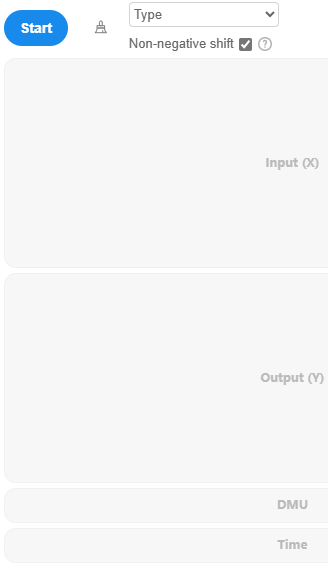Malmquist Index
Malmquist Index is used to measure productivity changes of production units over different time periods by comparing distance functions. It is located in SPSSAU -> Comprehensive Evaluation -> Malmquist Index.
SPSSAU Operations

Drag and drop analysis items, including Input (X), Output (Y), Decision-making Units (DMUs), and Time Terms, into the right panel, then click 'Start'. SPSSAU includes two parameters: Type and Non-negative Shift.
Type: The default is BCC (VRS, Variable Returns to Scale), but CCR (CRS, Constant Returns to Scale) can also be selected.
Non-negative Shift: When selected, if any column contains values ≤ 0, a shift is applied using (absolute value of the minimum value + 0.01) to ensure all data remains positive for accurate computation.
SPSSAU Data Format

Malmquist Index requires balanced panel data formatting. For example, if there are 10 years and 20 DMUs per year, the dataset should contain 10 × 20 = 200 rows.
Algorithm
1.Define Decision-making Units (DMUs)
Identify the input and output variable data. Input variables represent resources used in production and output variables represent products or services produced.
2.Calculate the Distance Function
For each DMU in each period, compute its distance function relative to the current and previous period's technology. The Distance Function is calculated using the DEA model:
: Inputs in period t and t+1.
: Outputs in period t and t+1.
Pt,Pt_1: Production possibility sets for period and t + 1.
3.Calculate the Malmquist Index
The Malmquist Index is defined as:
: Distance function with period t's production frontier as the benchmark.
: Distance function with period t+1's production frontier as the benchmark.
TFP Malmquist TFP Index. Malmquist TFP Index > 1: Productivity has improved. Malmquist TFP Index < 1: Productivity has declined. Malmquist TFP Index = 1: Productivity remains unchanged.
4.Decomposition of the Malmquist Index
Malmquist Index can be further decomposed into: Technical Progress Change (TC) and Technical Efficiency Change (EC):
TFP = EC × TC
TC>1 indicates technological advancement.
EC>1 indicates improved technical efficiency
EC can be further decomposed into: Scale Efficiency Change (SEC) and Pure Technical Efficiency Change (PEC):
EC = SEC × PEC
5.Model Computation
SPSSAU utilizes the MIP package for mathematical computations.
References
【1】The SPSSAU project (2024). SPSSAU. (Version 24.0) [Online Application Software]. Retrieved from https://www.spssau.com.
【2】MIP: Mixed Integer Programming in Python(Version 1.15.0). GitHub. https://github.com/coin-or/python-mip.
【3】PuLP: A Linear Programming Toolkit for Python (Version 2.6.0). Available at: https://github.com/coin-or/pulp.